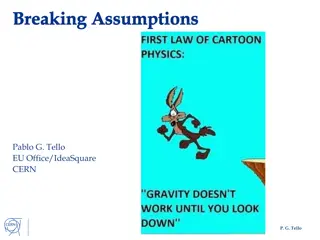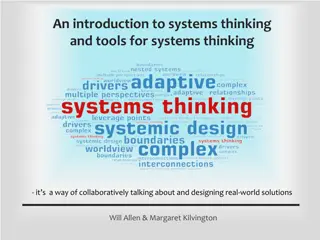Understanding Systems Thinking: Concepts Illustrated with a Bathtub Example
Explore systems thinking through the concept of a bathtub, where water flow and levels represent interconnected parts of a system. Learn how to interpret systems diagrams and understand key terminology in a practical context.
Uploaded on Sep 18, 2024 | 0 Views
Download Presentation

Please find below an Image/Link to download the presentation.
The content on the website is provided AS IS for your information and personal use only. It may not be sold, licensed, or shared on other websites without obtaining consent from the author. Download presentation by click this link. If you encounter any issues during the download, it is possible that the publisher has removed the file from their server.
E N D
Presentation Transcript
Introduction to systems thinking terminology A system is a set of connected things or parts forming a complex whole
How do you rate your knowledge of systems diagrams right now? 1. I have never heard of systems diagrams. 2. I have heard of systems diagrams, but cannot elaborate. 3. I could explain a little about systems diagrams. 4. If given a systems diagram, I could explain it. 5. I could create a systems diagram and then explain it.
Introduction to systems thinking Goals: Define systems terminology. Read and interpret simple systems diagrams. Evaluate a diagram s fit to a description of a system.
Describe how a bathtub works (in 3 minutes) Take out a blank sheet of paper and write 2 4 complete sentences. (now turn over the paper and set it aside until the end of class)
Here is my bathtub, visually: faucet Water in bathtub drain
The water in the bathtub is the reservoir faucet We measure the amount in the reservoir Water in bathtub Water level in cm Liters Gallons drain
The faucet represents a flux: the input or inflow of water We measure the rate of water flowing through the faucet faucet Water in bathtub Liters/second Drops/minute drain
The drain also represents a flux: the output or outflow faucet We measure the rate of water flowing down the drain Water in bathtub Liters/second Drops/minute drain
Open system faucet That is, we have not connected both ends of the arrows to the ultimate sources and sinks of water. If you wanted to draw a closed system, what might you add? Water in bathtub drain
Closed system Water in hot water heater faucet Now we do not have any unconnected arrows! If you wanted to draw a closed system, what might you add? Water in bathtub Lets say you want to disconnect from town water drain Basement tank
Closed system with feedback loop Water in hot water heater faucet If you wanted to recycle your bathwater, you might connect some home water-purifying system Water in bathtub purifier drain Basement tank
Water heats to 104oF Water in hot water heater Hot water heater turns on Hot water heater turns off Water cools to 102oF Which type of feedback loop is in the hot water heater? Balancing (negative) feedback loops hold a system to an equilibrium state and make it more stable. Reinforcing (positive) feedback loops tend to move a system away from equilibrium and make it more unstable.
Water heats to 104oF Water in hot water heater Hot water heater turns on Hot water heater turns off Water cools to 102oF Which type of feedback loop is in the hot water heater? Balancing (negative) feedback loops hold a system to an equilibrium state and make it more stable. Reinforcing (positive) feedback loops tend to move a system away from equilibrium and make it more unstable.
Reinforcing feedback loops underlies many environmental problems Recall: Reinforcing feedback loops tends to make a system more unstable. Examples: loss of biodiversity degradation of agricultural soils global climate change To address these problems, we need to consider complex interactions, rather than merely one component alone or a single cause-and-effect relationship!
Systems thinking is an essential tool for addressing societal challenges Such as energy, food, water resources climate change poverty hazards These challenges cut across human and natural systems, involve multiple interdependent variables and feedbacks that are changing over time and space and are critically important, yet complex to predict
Recall todays goals Define systems terminology. Read and interpret simple systems diagrams. Evaluate a diagram s fit to a description of a system. Now we will do this
Listen to the first 2:00 of this news story http://play.publicradio.org/default/d/podcast/minnesota/podcasts/climate_cast/20 15/07/millerclimatecast_20150709_64.mp3 (until Eric S. Kasischke begins speaking) Write down anything you can identify as influencing climate.
Work with a partner to compare lists then sort into categories: - fluxes - reservoirs - feedbacks (3 minutes!)
With your partner discuss: Does the diagram fully represent the complexity of the system described by the speaker? If not, add to the diagram. Length of summer Heat in the atmosphere Dry trees, plants Radiative heating Radiative heating Wildfire Smoke over Minnesota Smoke over Canada Wind
One option Length of summer Heat in the atmosphere Dry trees, plants Radiative heating Radiative heating Wildfire Smoke over Minnesota Smoke over Canada Wind Albedo Dirty/sooty ice Deposition
Your answers Length of summer Heat in the atmosphere Dry trees, plants Radiative heating Radiative heating Wildfire Smoke over Minnesota Smoke over Canada Wind
How is your bathtub different from the simple open system bathtub we imagined in class? 1. On the back of your bathtub description, draw a system diagram of your bathtub at home and use systems vocabulary to explain how it works in a paragraph. 2. Using systems vocabulary, write a paragraph to explain the differences. 3. What questions do you still have about your diagram?
How do you rate your knowledge of systems diagrams right now? 1. I have never heard of systems diagrams. 2. I have heard of systems diagrams, but cannot elaborate. 3. I could explain a little about systems diagrams. 4. If given a systems diagram, I could explain it. 5. I could create a systems diagram and then explain it. And, reflect briefly on your learning today: What aspect of class most helped you improve your knowledge of systems? Why?























